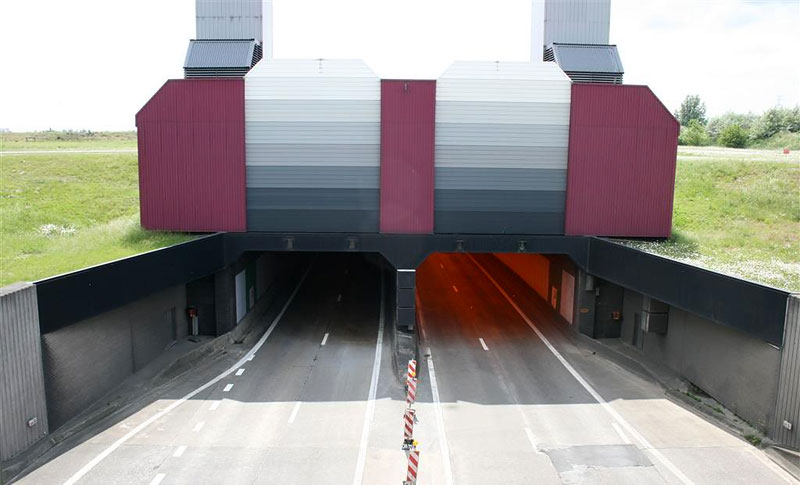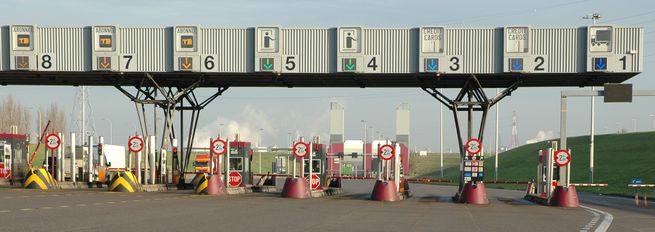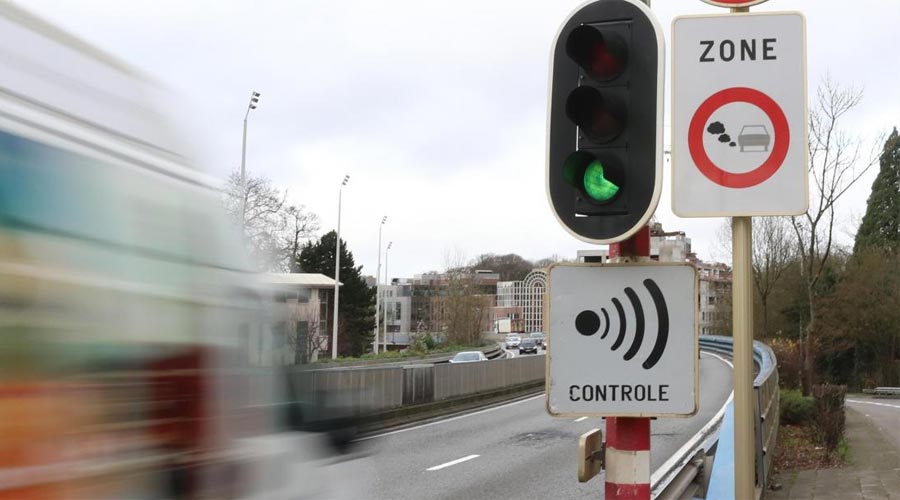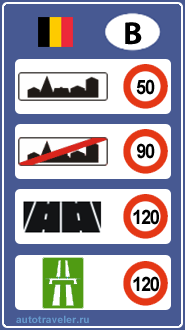Driving in Belgium
The total length of roadways of Belgium is 154,012 km. Length of motorways - 1,763 km. In Belgium all roads are paved.
ContentsToll roads
There is no charge for driving foreign vehicles on Belgian roads.
The fee is charged only for travel on certain sections.
Tunnel Liefkenshoek
You have to pay for the passage through the Liefkenshoek Tunnel, which is located near Antwerp and runs under the Scheldt River. The Liefkenshoek tunnel is 1.37 km long and is part of the R2 ring road around Antwerp.

Tunnel location: Google Maps, Google Earth.
Tariffs are divided into 2 categories. Unlike most European countries, when determining the category, only the height of the vehicle is taken into account - up to 3 m and above. The exact height is measured electronically.
Other criteria (number of axles, length, weight or their combination) are not used to determine the category!
Toll rate at 2024:| VEHICLE | Category | CASH | CREDIT CARDS | TELEPASS |
|---|---|---|---|---|
| Category 1 (height < 3 m) (all-day) |
€ 7.00 | € 4.00 | € 5.60 | |
| Category 2 (height ≥ 3 m) (from 06:01 to 21:59) |
€ 22.00 | € 16.00 | € 19.90 | |
| Category 2 (height ≥ 3 m) (from 22:00 to 06:00) [1] |
€ 7.00 | € 4.00 | € 5.60 |
[1] From 1 July 2017.
The toll station has a total of 18 gates, with 9 lanes in each direction of travel (numbered from 1 to 9).

Lanes 1 through 3 are for credit card payments (indicated by a blue arrow). Also, these lanes can be used by vehicles equipped with the Telepass system.
Lanes 4 through 5 are for cash payments (indicated by a green arrow).
Lanes 6 to 8 are intended for vehicles equipped with the Telepass system (indicated by a yellow arrow).
Payment Methods
CASH
Payment is due upon entry. Euro cash is accepted, as well as the following currencies: US dollar, Danish krone, Swedish krona, Swiss franc and British pound sterling. All currencies are converted to euros!
CREDIT CARDS
The following credit cards are accepted for payment:
- Visa
- Eurocard - Mastercard
- American Express
- Diners
TELEPASS (electronic payment)
Payment is made automatically when driving through the gate.
Ecological zones (LEZ) in Belgium
LEZ - «Low Emission Zone». This term is used to refer to a situation where polluting vehicles are not allowed to drive in a given city or areas of that city. This is one of the measures taken in many European cities to improve air quality.
From 1 January 2018, the use of the most polluting vehicles in the Brussels LEZ is prohibited. This applies to passenger cars, minibuses ≤ 3.5 tonnes, as well as buses registered both in Belgium and abroad.

So far, the ban applies only to very old cars that meet the requirements of EURO-1 and below. But every year the requirements will become tougher.
To enter such a zone, you must register using the electronic form on site . Registration is free and will be valid for 3 years.
If a vehicle enters a low emission area and has not been registered in advance, a fine of € 150 may be imposed (even if the vehicle meets the conditions for access to the low emission area). Any inaccurate information provided at registration will be subject to an administrative fine of € 25.
If the vehicle does not meet environmental requirements, then a one-day pass must be purchased to enter such an area. The cost of the pass is € 35 per day.
The checks are carried out on the basis of car license plates using cameras. A network of 191 cameras was installed throughout the Brussels Region (both at the border of the zone and within it).

In addition to Brussels, there is a similar ecological zone in Antwerp.
Parking in Belgium
Parking is paid on most central streets in cities. After payment, you need to put a receipt under the windshield so that it can be clearly seen from the outside.
On some streets, parking may be free, but limited in time (Blauwe zone). In this case, you must put a blue cardboard clock under the windshield, on which the arrival time is set. Blue watches can be purchased at gas stations, kiosks, and police stations.
Be aware that temporary signs may be placed on the left side of the road to indicate that the road must be clear for road works. Drivers who ignore this requirement risk their vehicle being towed to a fine parking lot.

Some very busy streets may have a sign (Ax Rouge/Ax Rode), which means that parking is not allowed from 07:00 to 09:30 and from 16: 00 to 18:00.
Motorcycles can be parked on the sidewalk in the city center if there is at least 1.50 meters of free space for pedestrians.
Map of Belgium roads
Buy a Benelux Road Map on Amazon
Road rules in Belgium
Speed limits

Standard speed limits in Belgium (unless otherwise indicated on the signs).
Cars (to 3.5 tons) and motorcycles:- built-up areas - 50 km/h
- outside built-up areas - 90 km/h (70 km/h) [1]
- expressway - 120 km/h
- motorway - 120 km/h
- built-up areas - 50 km/h
- outside built-up areas - 90 km/h (70 km/h) [1]
- expressway - 120 km/h
- motorway - 120 km/h
[1] From January 1, 2017, the maximum speed outside the village in Flanders (administrative region in the northern part of Belgium) is 70 km/h.
The minimum speed limit on the motorway is 70 km/h.
In the area covered by the "Residential area" sign, the speed of vehicles must not exceed 30 km/h.
Be careful — there are a large number of speed cameras in Flanders and when approaching Brussels.
The current maximum speed limits on the roads of European countries for cars.
Alcohol
The maximum permitted level of alcohol in the bloodstream is 0.49 ‰.
If the level of alcohol in the bloodstream exceeds the allowable, a fine will be imposed:
- from 0.5 ‰ to 0.79 ‰ - driving will be prohibited for 3 hours and a € 150 fine on the spot will be imposed. If you refuse to pay on the spot, you may be prosecuted and fined up to € 3,000.
- above 0.8 ‰ - driving will be prohibited for at least 6 hours, and a € 600 fine on the spot will be imposed. If you refuse to pay on the spot, you may be prosecuted and fined up to € 12,000, and your driving license will be revoked for up to 5 years.
If your driving experience is less than 2 years, there is no penalty and you are automatically prosecuted.
The maximum permitted alcohol limit for drivers in European countries.
Dipped headlights
Dipped headlights is not required when driving in the daytime. The dipped headlights should be switched on during the day in conditions of poor visibility.
In which European countries is the use dipped headlights in daytime mandatory?
Children in cars
Children under 12 years of age and less than 135 cm tall should only be transported in special seats. A child under the age of 3 cannot be transported in a car without a child seat.
Children from 3 to 8 years old can only be transported on a motorcycle in child restraints appropriate for their weight.
The carriage of children under 3 years of age on motorcycles is prohibited. This rule also applies to children carried in a stroller.
Fine — € 50.
Seat belts
Seat belts is mandatory for both front and rear passengers.
Fine — € 50.
Mobile phone
It is forbidden to use a mobile phone that is not equipped with a technical device that allows negotiations without the use of hands while the vehicle is in motion.
Fine from € 100.
Mobile phone while drivig in Europe
Penalties for using mobile phone while driving in Europian countries.
Window Tinting
The degree of light transmission of the front and front side windows must be at least 70%.
For rear windows, the degree of light transmission is not regulated.
If the rear windshield is tinted, it is necessary to have a rearview mirror on the side opposite to the driver's side.
Motorcycles
Motorcyclists are required to wear not only a helmet, but also gloves, a long-sleeved jacket, long trousers or overalls. In addition, boots or boots must protect the ankles.
Failure to comply with these rules will result in a fine of € 50.
In case of traffic jams, motorcyclists are allowed to move between lanes. At the same time, the speed of their movement should not exceed 50 km/h, and the difference in speed with slow moving or standing vehicles should not be more than 20 km/h.
Motorcycles, mopeds and bicycles are allowed to use the lanes intended for buses, except for cases when this is prohibited by appropriate signs.
Motorcycles with a sidecar are allowed to move with a trailer if the wheel of the sidecar is equipped with brakes.
Penalties
Police officers in Belgium have the right to collect fines on the spot. The police officer must issue an official confirmation stating the amount of the fine. The motorist can refuse to pay the fine on the spot.
A foreign motorist who refuses to pay a fine on the spot may be asked to pay a deposit. And if the deposit is not paid within 96 hours, the vehicle will be confiscated by the police until it is paid. Fines can be paid in EUR cash (foreign drivers only), postal order or credit/debit card.
Traffic violations in Belgium are divided into 4 groups:
- I — is punishable by a fine of € 50 if paid on the spot and from € 55 to 1,375 when the case is being considered in court.
- II — is punished with a fine of € 100 if paid on the spot and from € 110 to 1.375 when the case is being considered in court. In this case, the deprivation of a driver's license and suspension from driving a car is possible.
- III — is punished with a fine of € 150 if paid locally and from € 165 to 2,750 if the case is being considered in court. In this case, the deprivation of a driver's license and suspension from driving a car is possible.
- IV — is punished with a fine of € 300 (for foreign drivers only). For residents, the case is always considered in court and is punished with a fine from € 220 to 2,750.
| Violation | Group | Fine (EUR) * |
|---|---|---|
| Driving on the left lane with a free right on the road with two lanes in the same direction | I | 50 |
| Throwing garbage or other objects from the vehicle | II | 100 |
| No signals when the speed drops significantly | II | 100 |
| Failure to comply with a distance of 50 m outside built-up areas | II | 100 |
| Failure to grant priority in movement to trams | II | 100 |
| Overtaking on the right | II | 100 |
| Stopping or parking on a sidewalk, crosswalk or cycle path | II | 100 |
| Failure to grant priority in movement to pedestrians in a pedestrian zone | III | 150 |
| Lack of low beam headlights when visibility is less than 200 m | III | 150 |
| Non-observance of signs the passage is prohibited or overtaking is prohibited | III | 150 |
| Violation of the rules for driving a railway crossing | IV | 300 |
| Stopping or parking at an intersection | IV | 300 |
* when paying on the spot.
A fine on the spot will not be charged if the offender is under 18 years of age or damage is caused to third parties.
Speeding fines in Belgium:| Over speed | ||
|---|---|---|
| to 10 km/h | € 50 | € 50 |
| above 10 km/h | € 50 + € 10 for each additional 1 km/h | € 50 + € 5 for each additional 1 km/h |
Examples of calculating fines for speeding at 7 km/h:
In built-up area: € 50 + (7 х € 10) = € 120
At motorway: € 50 + (7 х € 5) = € 85
If the speed is exceeded over 20 km/h in built-up area and over 30 km/h outside it, the driver's license is revoked.
If the speed exceeds 30 km/h in built-up area and over 40 km/h outside it - a mandatory suspension from driving.
Fines for violation of traffic rules in Belgium in English (853 Кб).
Useful information
Fuel prices
Unleaded petrol (95 and 98) and diesel are available in Belgium. There is no leaded gasoline. There are LPG stations.
Official fuel prices are regulated by the government. The official price is the maximum permitted price for petroleum products.
Official prices for all types of fuel at 2025-07-02:
- E10 (95) — € 1.605
- E5 (98) — € 1.679
- B7 (Diesel) — € 1.709
- LPG — € 0.741
Trends gasoline prices in Belgium for last years.
It is allowed to carry gasoline in cans in a car, moving around the country, and is prohibited when transporting by ferry.
Changes from the previous period are shown. Update every two weeks.
Emergency phone numbers
- European emergency number – 112
- Fire – 100
- Police – 101
- Ambulance – 100
Compulsory to carry in car
- Reflective jacket - drivers stopping in areas where stopping is prohibited are required to wear a reflective vest as soon as they leave their vehicle. The penalty for non-compliance is € 50.
But the amount can be much higher (€ 60 - € 1,500) if the driver refuses to pay or under circumstances where the driver must go to court (for example, in the event of an accident). A reflective vest is compulsory for vehicles registered in Belgium.
Although the driver of a foreign vehicle will not be fined for not wearing a vest in the event of a police check, but a fine may be imposed for not having a vest when exiting the vehicle in the event of a breakdown - Warning triangle - optional for motorcycles.
Winter equipment
Winter tires
The use of winter tires in Belgium is optional, but recommended from October 1 to April 30 in mountainous areas.
Spiked tires
The use of studded tires is prohibited, but in exceptional cases (in difficult weather conditions) it can be allowed from November 1 to March 31 for vehicles weighing up to 3.5 tons.
Cars equipped with studded tires must have a «60» speed limit sticker on the back. They are subject to the following speed limits - 90 km/h on motorways and 60 km/h on normal roads.
Snow chains
Snow chains may only be used on roads covered with snow or ice.
Winter equipment for car in Europe
Requirements for using of winter and studded tires in different countries of Europe.
Optional equipment and other rules
A first aid kit and a fire extinguisher are mandatory for vehicles registered in Belgium. For vehicles registered in other countries, this is a recommendation.
A new road sign has been introduced to prohibit the use of cruise control on congested highways. Sometimes this sign is installed when carrying out road works on the motorway.
Navigation software is permitted to indicate the location of fixed speed cameras.
Most railway crossings in Belgium are equipped with cameras. Crossing at a time when it is prohibited, i.e. red lights can result in a fine of up to € 2,750.
The use of radar detectors is prohibited. In case of violation, a fine of € 75,000 or imprisonment from 15 days to 3 months. The device is confiscated.
